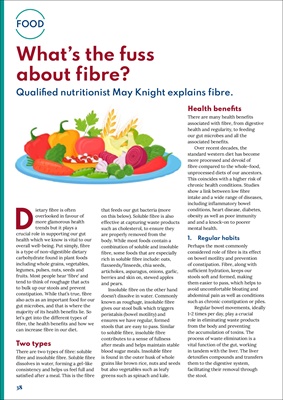
38
FOOD
What's the fuss
about fibre?
Qualified nutritionist May Knight explains fibre.
Dietary fibre is often
overlooked in favour of
more glamorous health
trends but it plays a
crucial role in supporting our gut
health which we know is vital to our
overall well-being. Put simply, fibre
is a type of non-digestible dietary
carbohydrate found in plant foods
including whole grains, vegetables,
legumes, pulses, nuts, seeds and
fruits. Most people hear 'fibre' and
tend to think of roughage that acts
to bulk up our stools and prevent
constipation. While that's true, fibre
also acts as an important food for our
gut microbes, and that is where the
majority of its health benefits lie. So
let's get into the different types of
fibre, the health benefits and how we
can increase fibre in our diet.
Two types
There are two types of fibre: soluble
fibre and insoluble fibre. Soluble fibre
dissolves in water, forming a gel-like
consistency and helps us feel full and
satisfied after a meal. This is the fibre
that feeds our gut bacteria (more
on this below). Soluble fibre is also
effective at capturing waste products
such as cholesterol, to ensure they
are properly removed from the
body. While most foods contain a
combination of soluble and insoluble
fibre, some foods that are especially
rich in soluble fibre include: oats,
flaxseeds/linseeds, chia seeds,
artichokes, asparagus, onions, garlic,
berries and skin on, stewed apples
and pears.
Insoluble fibre on the other hand
doesn't dissolve in water. Commonly
known as roughage, insoluble fibre
gives our stool bulk which triggers
peristalsis (bowel motility) and
ensures we have regular, formed
stools that are easy to pass. Similar
to soluble fibre, insoluble fibre
contributes to a sense of fullness
after meals and helps maintain stable
blood sugar meals. Insoluble fibre
is found in the outer husk of whole
grains like brown rice, nuts and seeds
but also vegetables such as leafy
greens such as spinach and kale.
Health benefits
There are many health benefits
associated with fibre, from digestive
health and regularity, to feeding
our gut microbes and all the
associated benefits.
Over recent decades, the
standard western diet has become
more processed and devoid of
fibre compared to the whole-food,
unprocessed diets of our ancestors.
This coincides with a higher risk of
chronic health conditions. Studies
show a link between low fibre
intake and a wide range of diseases,
including inflammatory bowel
conditions, heart disease, diabetes,
obesity as well as poor immunity
and and a knock-on to poorer
mental health.
1. Regular habits
Perhaps the most commonly
considered role of fibre is its effect
on bowel motility and prevention
of constipation. Fibre, along with
sufficient hydration, keeps our
stools soft and formed, making
them easier to pass, which helps to
avoid uncomfortable bloating and
abdominal pain as well as conditions
such as chronic constipation or piles.
Regular bowel movements, ideally
1-2 times per day, play a crucial
role in eliminating waste products
from the body and preventing
the accumulation of toxins. The
process of waste elimination is a
vital function of the gut, working
in tandem with the liver. The liver
detoxifies compounds and transfers
them to the digestive system,
facilitating their removal through
the stool.